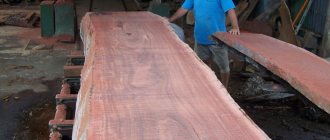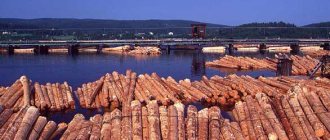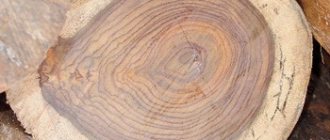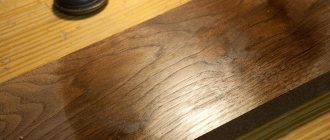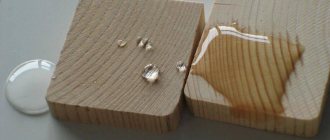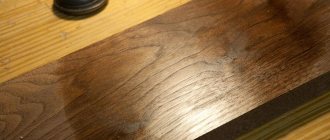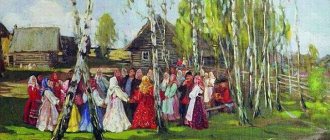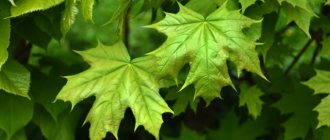a relatively hard and durable fibrous material, the main part of the trunks, branches and roots of trees and shrubs hidden by bark. It consists of countless tube-shaped cells with shells mainly of cellulose, firmly cemented with calcium and magnesium pectates into an almost homogeneous mass. In its natural form it is used as a building material and fuel, and in crushed and chemically processed form - as a raw material for the production of paper, fiber boards, and artificial fiber. Wood was one of the main factors in the development of civilization and even today remains one of the most important types of raw materials for humans, without which many industries could not do.
Also on topic:
CELLULOSE
Sources.
Although ferns also have woody tissue, people obtain almost all their wood from the trees of the two main divisions of the kingdom of higher plants - gymnosperms and angiosperms. Gymnosperms are a very ancient form, represented exclusively by woody species, which include conifers (“softwoods”), namely pine, spruce, cedar, which supply the bulk of the wood used by mankind. The angiosperm department is distinguished by great diversity and is divided into two classes - monocotyledons and dicotyledons. Only a few monocots (bamboo, palms, yucca) produce woody tissue, which is of limited, mainly local, importance. As for dicotyledons, this class includes important deciduous (“hard”) species - oak, eucalyptus, maple, the wood of which is especially valuable for furniture, interior decoration, etc.
Structure.
Also on topic:
TREE
Wood cells, like bark cells, arise from repeatedly dividing procambium and cambium cells, which form an almost continuous layer of educational tissue between the bark and wood. The cambium arises from cells separated from the growth cone of the stem or root. The latter originates in the cellular educational center of the embryo in the seed. There are two classes of cells in wood - parenchymal and prosenchymal. Parenchyma cells are usually thin-walled with simple (not bordered) pores. In sapwood they perform the function of physiologically active living tissue (provide storage of nutrients). Prosenchymal cells are thick-walled with bordered pores. They lose their protoplast as they grow and reach their final wall thickness, whereupon they become a fluid-conducting and support-providing medium.
Wood is characterized by annual rings, caused by changes in cell size and cell wall thickness due to changes in growth conditions. In temperate climate zones, the contrast of rings is associated with the difference between the “summer” wood of one year and the “spring” wood of the next. The age of the tree can be determined by the number of rings at ground level.
Macroscopic structure of wood
If the structure of the trunk is visible to the naked eye on the cut, then they talk about such a thing as the macrostructure of wood. It happens that not the entire cut plane is colored evenly: closer to the center it may be darker, and further away it may be lighter. The dark part, the strongest, created from dead tissue cells, is the heartwood, and the light part is the sapwood. Nuclear cells die due to blockage of conducting vessels by resin. Wood species with this color are called sound wood (oak, pine, ash, larch). If the cut is uniformly colored, then such species are coreless (alder, birch).
Each year of life is marked on the trunk by an increase in a layer of wood of a certain size, which depends on the age, living conditions of the plant, and growth rate. Such layers are called tree rings. They are especially clearly visible on coniferous wood cuts.
The growth ring contains two layers of tissue such as:
- Early soft. Occurs in the first half of the annual growing season. Has a light color. Located at the center of the trunk.
- Late hard. Created in the second half of the annual growth. Differs in dark color. Located closer to the bark.
Nutrient elements are transported through the channels of early tissue to the apex and back. The late layer zone protects the plant from mechanical damage. The butt contains the narrowest rings. Due to poor growing conditions, they may have waviness, which increases the decorative value of the wood pulp. The wood material with the narrowest rings is considered the best.
Light lines are drawn from the bark along a radius to the center of the plant, used to move nutrients. These lines are called medullary rays. Rays are characteristic of all breeds. They are clearly visible in sections. The width of the beams varies within 0.05 - 1 mm. Their size directly depends on the living conditions of the plant. The medullary rays are responsible for the texture of wood pulp. Some of them are interrupted far from the core. Such rays are called secondary, in contrast to the primary ones, which reach it.
On a cross section of deciduous trees, small holes are noticeable, which are the vessels of the plant. They supply the tree with water and nutrition. If large vessels lie in the early layer, and small ones in the late layer, then such a vascular pattern corresponds to ring-vascular matter (oak, elm, ash). It is characterized by durable wood pulp. The uniform arrangement of vessels along the annual ring corresponds to soft scattered vascular tissue (birch, aspen). In the spring, sap is collected from some trees (birch, sugar maple) by cutting their vessels.
The structure of conifers is characterized by ducts filled with resin. These are resin ducts, which are characteristic only of some coniferous trees. For example, fir and juniper do not have them. Resin passages in different directions create one resin-bearing system.
The very center of the trunk is occupied by the pith, a loose mass that penetrates the plant from bottom to top. Quickly decomposes. It is created at the beginning of the tree's life. On a cut, the core appears as a mark, usually round in shape with a diameter of 2 - 5 mm. Deciduous trees have a larger core area than conifers. Elderberry has the largest core.
The thin, slimy layer of cells lying in the area between the bark and the wood is called the cambium. It produces microelements for the growth of woody tissue, taking nutrients from the bast. Beginning in the spring, the process of synthesizing new cells ends in the fall. This explains the layered structure of wood pulp.
Chemical composition.
Also on topic:
TIMBER INDUSTRY
Wood contains a number of complex organic compounds. Full chemical analysis shows that it contains about 50% carbon, 6% hydrogen and 44% oxygen. The cell wall has a network structure of interconnected long-chain cellulose molecules, filled with other hydrocarbons (hemicelluloses), as well as lignin and various extractives. The cementing intercellular substance is mainly calcium and magnesium pectates, and resins, gums, fats, tannins, pigments and minerals accumulate in the cellular cavities, especially in deciduous wood. The composition of wood includes 45–60% cellulose, 15–35% lignin and 15–25% hemicelluloses. The amount of foreign, extractive substances largely depends on the species and is not the same in sapwood and heartwood. The mineral content (ash content) of wood is usually significantly less than 1%.
Microscopic structure of wood
Only the microscopic structure of wood fully answers the question: what is wood? A lot of different cells, fastened together - this is wood pulp. Each cell is filled with protoplast, and the intercellular space is filled with complex polymer compounds. Cells that are unique in structure and function create the corresponding tissues: mechanical (supporting), conducting and storage.
The cell membrane is created from natural high-molecular polymers: carbohydrates (70 - 80%) and lignin (20 - 30%). The carbohydrate part is represented by holocellulose, hemicellulose and cellulose. Lignin is an amorphous substance that binds cellulose fibers together, due to which cellulose acquires strength and elasticity. Lignin and cellulose permeate cell walls, causing them to become lignified. As a result, the shell becomes rigid, hard, and is not inferior in strength to reinforced concrete.
Physical properties.
The relative density of wood ranges from 0.1 (balsa) to ~1.3 (ironwood and some other tropical species). The relative density of most industrial wood is 0.2–0.75, density – 190–850 kg/m3. The relative density of wood matter is approximately 1.5. Consequently, only about 1/6 of the volume of light industrial wood is solid matter, while in heavier grades it accounts for about half the volume. The relative density can be different for one tree species, which is due to the variability of growing conditions. Thus, for long-leaf pine this value can range from 0.25 to 0.80 (average value 0.53).
Both standing wood and industrial wood strongly absorb water, which is due to its capillary structure. Free water fills the cellular cavities, and bound water is retained due to adsorption in the spaces between the fibers. When all free water has been removed during drying, so that the entire vascular system is filled with bound water, the wood reaches the point of fiber saturation, which for most species corresponds to a moisture content of about 28%. Further removal of water leads to shrinkage, since when adsorbed water is desorbed, the fibers shrink and the lumen of the vessels decreases.
Depending on the presence of moisture, wood shrinks or swells. Shrinkage from the saturation point of the fibers to the state after drying in an oven is maximum (4–14%) in the tangential direction (parallel to the growth rings), approximately half as much (2–8%) in the radial direction (across the growth rings) and is practically absent (0. 1–0.2%) along the fibers. Tangential, radial and volumetric shrinkage are approximately proportional to the change in the moisture content of the wood.
The mechanical properties of wood are closely related to its fiber-cellular structure. Its strength is maximum along and quite low across the fibers. The tensile strength (per unit mass) of wood when stretched along the grain is 40 times, and when compressed, 3–4 times greater than that of steel. The compressive strength along the fibers is approximately 6 times, and the shear strength is approximately 4 times greater than across the fibers. Since compressive and bending forces are typical in structures, wood is particularly suitable for use in building structures as columns and short beams. Almost all strength properties of wood vary proportionally to density and inversely proportional to moisture content below the saturation point of the fibers. The inclination of the fibers, i.e. deviation of their direction from the longitudinal axis reduces the strength of the wooden structural element. In the same way, it decreases if there are knots in boards and logs, embedded parts of branches that disrupt or completely interrupt the flow of fibers. However, in the absence of tensile and bending loads, small knots are acceptable. The strength of wood is also reduced due to damage by putrefactive microorganisms and insects.
The structure of a tree, its main parts
The plant world is divided into lower and higher plants, which are characterized by the presence of roots, stems and leaves.
A number of physiological processes necessary for the growth and development of plants occur in them. In a growing tree, roots, trunk and crown are distinguished (Fig. 1). Rice. 1. Parts of a growing tree: 1 - roots; 2 - trunk; 3 – crown
Roots 1 constitute an entire system, which includes small roots that absorb water with minerals dissolved in it, and thick roots that conduct water and store nutrients, and also help maintain the tree itself in an upright position.
Trunk 2 supports the tree crown and connects it to the roots. Solutions of mineral substances move along the trunk in an ascending current, and solutions of organic substances formed in the foliage move in a descending current. The trunk also accumulates and stores nutrients.
Crown 3 is a collection of branches covered with leaves or needles. In the green leaves of the crown, during the process of photosynthesis, complex organic substances are produced that are necessary for the life and growth of the tree, the formation mechanism of which is the process of absorbing carbon dioxide from the air and water coming from the soil, as well as the action of light. The tree crown is currently not widely used, although its biomass contains many valuable substances.
The study of the trunk is carried out on three main sections (Fig. 2): transverse, or end, when the section plane is perpendicular to the axis of the trunk; radial, when the section plane runs along the axis of the trunk; tangential, when the section plane runs along the axis of the trunk perpendicular to the radius of the end.
Rice. 2. Main sections of the trunk (b): P - transverse section, P - radial section, T - tangential section
The trunk makes up the bulk of the tree. In some breeds it accounts for up to 90% of the mass. The structure of a tree trunk is shown in Fig. 3.
The trunk is a cone-shaped body covered with bark 6. The bark protects the tree from external influences and damage. The inner part of the bark, which conducts organic nutrients formed in the leaves down the trunk, is called bast 5. In the center of the trunk there is a small-sized core 1. This low-quality part of the tree in cross section looks like a speck with a diameter of 2...5 mm of brown or brown color , most often round or oval in shape. The main part of the trunk is wood 3. Between the bark and wood there is cambium 4 - a thin layer of living educational tissue that serves to nourish and form wood and bark. As the diameter of the trunk increases, the proportion of bark decreases (the thickness of the bark decreases in the direction from the butt to the top).
Rice. 3. The structure of a tree trunk in transverse (P), radial (R) and tangential (T) sections: 1 – core; 2 - core; 3 - sapwood; 4 - cambium; 5 - bast; 6 – bark
Application in construction.
Wood is used in construction in forms such as square lumber (timbers, planks), veneer, plywood, railroad ties, posts, piles, posts, shingles, and fiberboard. The most consumed lumber is rectangular. They are produced by sawing logs, then trimmed to standard widths and lengths, graded for quality, dried and supplied to consumers in raw, processed or molded form. Plywood is made by gluing an odd number of thin layers of wood (veneer) together so that the fibers of adjacent layers are mutually perpendicular. Plywood panels differ from conventional lumber in that (along with the absence of width restrictions) their strength is more uniform in different directions, they resist splitting better, and their dimensions change less under variable humidity conditions.
Fuel and wood pulp.
The use of wood as fuel throughout the world is still very important. In highly industrialized countries, fuel consumption of wood has continuously decreased over the past decades due to the transition to coal, gas, oil and electricity. This trend is likely to continue in the future as other types of fuel and heat sources become increasingly available with further developments in technology. The use of wood in the form of wood pulp, on the contrary, has been continuously increasing recently and is projected to continue to increase in the foreseeable future. Wood is converted into wood pulp by mechanical abrasion using water or by treatment with chemicals that break the lignin bond and release the fibers. The wood pulp is then converted into various types of paper, boxboard, and fiberboard. After special processing, it is used as cellulose raw material for the production of synthetic fabrics and plastics.
Features of choosing wood
Different types of wood differ not only in texture and color, but also in performance characteristics: hardness, strength, moisture and wear resistance.
- Products made from strong wood are more durable in use. Such wood is durable and less susceptible to external factors. But it is less easy to process, and it is almost impossible to make furniture out of it with your own hands.
- Moderate density wood is well suited for making furniture yourself. Soft varieties usually have good performance characteristics.
- For the kitchen, it is better to choose a set made of durable wood. Furniture made of wood of moderate density would be appropriate in the living room. Solid pine is good for a bedroom.
What material do you buy your furniture from?
WoodMetal
- Furniture made from dark wood is suitable for a spacious room, as it tends to visually reduce the space. However, such products look very cozy.
- Soft, light transparent shades will fit perfectly into a compact room. They go well with rich decor. For rooms with windows facing west, you can choose wood in light yellow shades. Pastel colors fill the room with light.
- Keep in mind that many types of wood respond well to staining, so if you choose solid wood, it doesn't always make sense to focus on color. Please note that applying varnish to the coating changes the natural tone, making it darker and more intense.
Each type of wood has its own characteristics, advantages and disadvantages. After studying them, you can choose the most suitable variety for making the necessary furniture.
Technology improvements.
Thanks to new technological developments, wood has become more widely used in traditional areas and has found new applications. Such advances include improvements in drying technology, anti-rot and fire-retardant treatments, layered structures, prefabricated structures, and high-performance wood adhesives. Great strides have been made in the pulp and paper industry, as well as in the production of chemically processed wood-based materials such as synthetic fiber, cellophane, alcohol, yeast, fiberboard, polymer-impregnated wood, wood laminates and various molded products. Progress in the processing and use of wood has stimulated further development of forestry.
